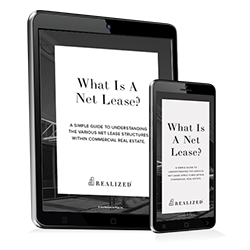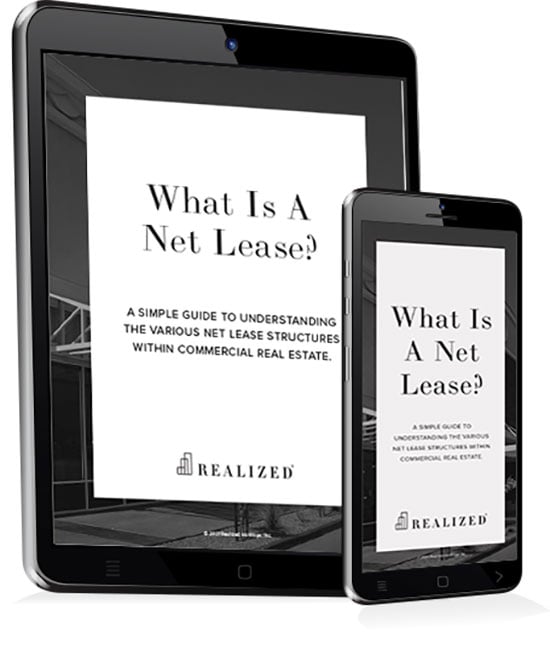
Single-Tenant Triple-Net property (also known as “Net-Lease”, “STNL” or “NNN”) refers to a property 100 percent leased to one tenant with a lease structure in which the tenant is responsible for all property-related expenses, leaving the landlord with minimal responsibilities. NNN properties are a popular choice for individuals who wish to invest in real estate, but may not have the time or desire to actively manage a property.
“Triple Net” refers to the tenant's expense responsibilities. The “nets” mean property taxes, insurance and operating expenses. There are also “Gross”, “Single-Net” or “Double-Net” leases, with each “Net” representing more responsibility falling on the tenant rather than the investor. For example, a tenant typically pays only property taxes in a “Single-Net” lease, whereas the tenant typically covers all taxes, insurance, and operating expenses in a “Triple Net” lease. It is important to note that there are a variety of perspectives on the definition of any lease. You should always read the actual lease agreement to truly understand the rental terms and conditions.
Single Tenant Net Lease Features
One attractive feature of various NNN properties is long-term leases. These properties often have new lease terms of 10 to 25 years and typically provide multiple lease renewal options. Of course these properties may be bought or sold at any point during their lease, thus an investor may not realize the full lease term.
NNN tenants span across a variety of property types including office and industrial. However, they are most prevalent in retail properties including fast food restaurants, convenience stores, gas stations, and big box stores.
Asking prices for Triple Net properties are typically quoted based on a cap rate, which is determined by dividing the property’s annual net operating income (NOI) by the purchase price. A cap rate is the initial unleveraged rate of return an investment is expected to produce. Since the tenant is responsible for all expenses, property income is generally equal to the rent paid by the tenant. For example, if a tenant pays $225,000 in annual rent and the building was purchased for $4,000,000, the cap rate would be 5.6% ($225,000/$4,000,000). Generally, riskier investments trade at higher cap rates, while more stable investments trade for lower cap rates.
Perhaps the most important factor when considering a Triple Net property is the tenant's credit quality. Because they only have a single tenant, the property's financial performance is largely attributed to the tenant’s ability to pay rent over the course of its lease. Larger companies are often assigned a credit rating by a credit agency (Standard and Poor’s, Moody’s, or Fitch). Credit ratings represent the likelihood of a company defaulting on its financial obligations. All else being equal, properties occupied by strong tenants with “investment-grade” ratings generally trade for lower cap rates than those with non-investment grade tenants.
Single Tenant Net Lease Considerations
STNL properties provide tenant rental income. But that is generally where the majority of potential investment returns come from as you get closer to lease-end. The further you are into the lease (proximity to lease-end), the harder it is to realize appreciation over time with an STNL. The property is typically most valuable at acquisition (when the lease term is longest).
For example, a 20-year lease is more valuable than a property with a 10-year lease, all else being equal. This is due to proximity to the lease-end and what ultimately happens with tenant lease renewal — will the tenant renew, or will the landlord have to find another tenant? It raises the question of whether projected cash flows will continue or not, and that affects the actual and perceived value of the property.
Landlords must also consider capital needs. Unless the property is under an absolute NNN lease, in which the tenant is responsible for all property-related risks, the landlord will be responsible for the property's structural portions. Landlord specific responsibilities will be outlined in the lease.
Binary risk is a concern related to single-tenant risk. With the property’s entire cash flow potential dependent on one tenant, the landlord has placed all of his eggs in one basket. While the lease provides some protections, if the tenant cannot pay, no lease can make up for lost income. For STNL properties, the tenant's creditworthiness is especially important.
Additionally, if the tenant vacates the property, it loses value. In that case, the property falls back to its "dark value" or “dark space.” Dark value is typically disclosed in the appraisal and provides a good sense of the property's intrinsic value. Basically, it means that the landlord still has to pay property taxes, insurance, and debt service, regardless of whether the space is leased.
In Conclusion...
STNL properties can provide passive investments with potentially long-term predictable cash flow. Although property risks can be partially mitigated by tenant quality, NNN properties are still subject to all real estate risks.
To learn more about single-tenant net lease properties, visit our NNN Tenant Profiles.
This material is for general information and educational purposes only. Information is based on data gathered from what we believe are reliable sources. It is not guaranteed as to accuracy, does not purport to be complete and is not intended to be used as a primary basis for investment decisions. It should also not be construed as advice meeting the particular investment needs of any investor.
Realized does not provide tax or legal advice. This material is not a substitute for seeking the advice of a qualified professional for your individual situation.
All real estate investments have the potential to lose value during the life of the investment. All financed real estate investments have the potential for foreclosure.
Hypothetical examples shown are for illustrative purposes only.
There is no guarantee that the investment objectives of any program will be achieved.



